#Bosporus Bridge
Explore tagged Tumblr posts
Text
The Rift Between Erdogan and Gulen: A Political Turmoil in Turkey
The Dramatic Split Between Erdogan and Gulen It was a spectacular and profound falling out. President Recep Tayyip Erdogan ascended to power with significant backing from a preacher and fellow Islamist, Fethullah Gulen, who sadly passed away this week. Gulen’s extensive following, consisting of millions of educated and motivated Turks, played a crucial role in filling key positions within the…
#2013#2016#Bosporus Bridge#corruption investigations#Erdogan#Gulen#Islamist movement#judicial coup#military coup#political rivalry#Turkey
0 notes
Text
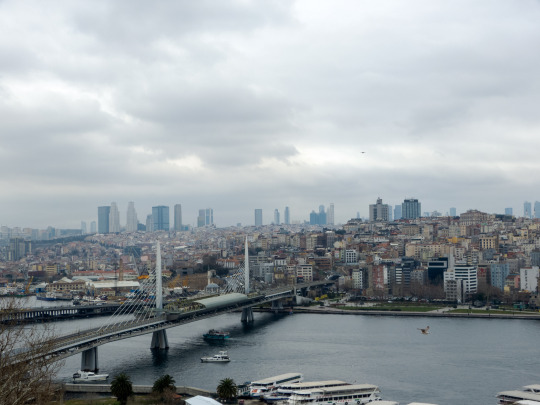
Istanbul, Türkiye.
#Istanbul#Türkiye#travel#travelphotography#old city#cityscape#cityview#landscape#city#river#bosporus#bridge#galata#karakol
53 notes
·
View notes
Text

Now this is a real find. Obscure as fuck, funky, breaky, arabic jazz and funk out of Turkey, recorded between 1968-78.
Found it in the random Jazz/Fusion box at my local shop and when i went to the till to pay for it, the owner tells me how much i will love it (he knows my style by now) and then starts to get a bit of a twitch about selling it to me...
"don't want to sell it to me now, do you Pete?"
"uhrm... no. no I don't..."
You could see it breaking his heart to sell it.
Still fucking walked out with it though!
Best track: Okay Temiz – Denizaltı Rüzgarları
youtube
Seriously, just watch this video and you will get exactly where it is coming from!
Bosporus Bridges - A Wide Selection Of Turkish Jazz & Funk 1968-1978, compiled by Lasarus & Roskow
1 note
·
View note
Text
📍Bosporus Bridge, Istanbul, Turkey 🇹🇷
#video#paradise#view#nature#paraiso#natureza#explore#travel#trip#ocean#sea#lake#bridge#istanbul#turkey#boats#birds#sky#sunset#cozy#vacation#landscape#old architecture#music#sun#travel destinations
141 notes
·
View notes
Text
Istanbul Mayor Ekrem Imamoglu made headlines in April after coasting to a second term in office by nearly 12 percentage points. Imamoglu, who has served at the city’s helm since 2019, is seen as a major political threat to Turkish President Recep Tayyip Erdogan and his Justice and Development Party (AKP). The latest win in Istanbul cemented Imamoglu’s continued popularity among the Turkish public.
But Imamoglu is only the most prominent face of a broader opposition, led by the Republican People’s Party (CHP). In March’s municipal elections, the CHP secured its most crushing victory over the AKP in decades. Possibly more notable than Imamoglu’s reelection was the newly elected class of women executives of provinces and districts across the country.
One of these women—Sinem Dedetas—may hold the keys to the future of Turkey’s opposition. Imamoglu is currently battling slander charges in the country’s high court, in addition to a slew of other cases that could eventually ban him from politics, even as he is the favorite to run for the CHP in Turkey’s 2028 presidential election. No matter how those fortunes play out, Dedetas promises to be central to the party’s strategy in a post-Erdogan Turkey.
Istanbul is the only city in the world to straddle two continents. Uskudar, a seaside constituency on the Anatolian side, lacks many of the bars and clubs across the water in the European districts. Instead, the conservative area is known for its historical mosques. It is also one of Istanbul’s key transportation hubs, home to a confluence of ferries, rail, metro, and bus lines. Millions of people from all over the city—and world—pass through Uskudar every day.
In April’s elections, Dedetas, a 43-year-old engineer, made history as the first woman to ever win the Uskudar municipality mayorship, a position similar to that of a New York borough president. She also flipped the district from the AKP to CHP rule.
Dedetas moved to Uskudar from her native Eskisehir, a city in northwest Turkey, for college in 1999. After receiving bachelor’s and master’s degrees in naval engineering from Istanbul Technical University, she got her first job in the district as an engineer. In 2014, she went on to work as a marine engineer at the Halic Shipyards, the oldest continuously operating dockyard in the world. Over the centuries, the facility has produced vessels from sail boats to steamships and submarines to electrical passenger taxis.
Dedetas’s career has featured many firsts. In 2014, she became the first chairwoman of the Turkish Chamber of Naval Engineers. While she was in that position, Istanbul’s AKP mayor tried to privatize the public harbor and turn it into a terminal full of restaurants and shops. Dedetas protested the project and was barred by the government from entering the shipyard.
She continued to oppose the new real estate development, concerned that the city’s ferries—an indelible part of Istanbul’s social history, skyline, and soundscape—would grind to a halt without the vital maintenance work done at the docks. “We fought to keep [it] from being lost,” Dedetas later said after her success in blocking the project.
Then Imamoglu became mayor of the city, bringing Istanbul back under CHP rule. “The privatization processes of the shipyard were being carried out,” Dedetas told Turkish media. “If [the mayorship] had not changed hands in the 2019 elections, there would be no shipyard left.”
One of the new mayor’s first orders of business was to appoint Dedetas as manager of Istanbul’s maritime public transportation system; she was the first woman in the role. Over the last quarter century, the city’s water transport fell into disarray as Istanbul’s population swelled and moved further inland, contributing to congestion and gridlock on road and rail. Yet municipal-run ferries predate the first Bosporus bridge and remain one of the city’s fastest options to cross continents.
Dedetas proved herself to be a masterful administrator, overhauling the entire water transit system. She opened 11 new ferry lines and launched a 24-hour weekend ferry that connected the European and Asian sides of the city. She also doubled the patronage of public water transport, in part by restoring the iconic white and orange vapur ferry ships. And she launched an electric sea taxi service, providing a personal, environmentally friendly option to traverse the Bosporus Strait and the Marmara Sea.
Through the effective management of maritime transportation, Dedetas gained national attention. She set her eyes on her home district, Uskudar—the Istanbul neighborhood with the longest Bosporus shoreline—ahead of the 2024 municipal elections. “Uskudar is the first gate for people who arrive from Anatolia, and for Istanbul, it is the gate to the rest of the country,” said Onur Cingil, an Uskudar native and CHP member.
The borough had been an AKP stronghold for as long as Cingil and most others could remember. It is even home to Erdogan’s private villa. Cingil said he saw local government officials claim eminent domain and exaggerate concerns about earthquake vulnerability to demolish buildings and hand over lucrative sites to construction companies, religious associations, and other party loyalists. “This happened … to my own student dormitory, and many other places,” Cingil said.
Cingil was one of the many CHP candidates vying to be the nominee for Uskudar’s mayorship in March’s elections, but the CHP leadership eventually selected Dedetas to run due to her reputation for being a technocratic consensus builder.
“Normally, I wouldn’t expect such a profile to be nominated for Uskudar,” said Burak Bilgehan Ozpek, a professor of political science at TOBB University of Economics and Technology. He described Dedetas’s young, professional, and secular profile as going against the grain in the district. The CHP typically nominated old-school, male party insiders for such roles, Ozpek said, adding with a laugh that they always lost the race. “This was a radical change,” he added.
Dedetas took a pro-people approach to her campaign against the AKP incumbent Hilmi Turkmen, who had been a mainstay in Uskudar’s politics for decades. She canvassed the district neighborhood by neighborhood, underlining her accomplishments governing the city’s maritime transit system, which has a budget the same size as Uskudar’s.
Dedetas vowed to redress the AKP’s neglect of women’s issues on both the district and federal levels. She promised to prioritize women’s employment and noted that, during her time helming Istanbul’s maritime transit system, she nearly tripled the number of women working there. She also proposed the creation of a free HPV vaccine program to protect against some forms of cervical cancer. (The cost of the vaccine has become nearly equivalent to Turkey’s monthly minimum wage.)
The candidate pledged to create child nurseries in every neighborhood in Uskudar. “This will enable women to work,” especially residents with low incomes, said Rumeysa Camdereli, an activist and member of Havle Women’s Association, the first Muslim feminist organization in Turkey.
Dedetas promised to expand welfare initiatives, and called for additional municipally subsidized cafeterias in Uskudar. Imamoglu created these during his first term for residents to get a healthy meal for just over a dollar, and his AKP competitor Murat Kurum mocked them on the campaign trail. “We are tired and bored of the rhetoric that tries to deceive the people by … giving half a tea glass of water or milk as if it is a service,” said Kurum. He also made fun of Imamoglu’s background as a kofte vendor.
Kurum’s gaffe turned off blue collar voters. Istanbul’s public eateries fill up every day for lunch and are vital in a country enduring a cost-of-living crisis amid annual inflation of nearly 70 percent.
“Local elections are less ideological and always more focused on services,” said Emine Ucak, the program director for social policy at the Reform Institute, an Istanbul-based policy center, who researches women in Turkish politics. “Women always think about their children, and they had stopped seeing a future for them.”
The campaign also focused on securing areas most vulnerable to earthquakes, a national concern after the devastating February 2023 earthquakes in Turkey’s southeast. Many locals fear that the slate block flats populating the hills above Uskudar’s wharf are in imminent danger in case of an earthquake. In response to their concerns, Dedetas is establishing a natural disaster directorate to help the district become prepared for earthquakes and other catastrophes.
On election night, Dedetas triumphed, beating Turkmen by more than seven percentage points. In doing so, she tore apart the long-held myth that Uskudar was an AKP stronghold.
“It’s a district with a lot of conservative families,” said Asli Aydintasbas, a visiting fellow at Brookings Institution. “For an uncovered woman to win is a real testament to her political appeal.” Unlike past CHP candidates, Dedetas shied away from the hardline, sometimes alienating secularism her party is known for. Pragmatism and empathy won the day.
Dedetas was not the only victorious woman on election day. Altogether, voters tripled the number of women mayors across Turkey. While only four female mayors had been elected in the previous municipal elections in 2019, 11 provinces and 64 municipalities are now governed by women, the vast majority of them representing opposition parties. Together, they won, on average, 53 percent of votes.
Female political representation is a welcome change after what many in the country see as backsliding on women’s rights under Erdogan. In 2021, Turkey exited the Istanbul Convention, an international treaty to combat gender-based violence that was drafted in the city a decade earlier. The Turkish president had urged women to have at least three children, claiming that those who reject motherhood are “deficient” and “incomplete.”
Although Turkey has a highly centralized political system, mayors remain key to managing districts and municipalities. They are where citizens first access the country’s welfare systems, and where businesses are registered, among other duties.
Following March’s elections, Dedetas and other mayors in the Turkish opposition now have their best chance in decades to govern with less interference from Ankara. She has wasted no time in initiating programs that address locals’ needs, such as grocery subsidies of up to $150 for retired residents. The district also plans to provide elderly residents free shuttle services to food markets. (Pensioners, who compose more than 10 percent of Turkey’s national population, receive roughly $293 per month from the state, an impossible wage to live on in Istanbul.)
Uskudar’s new mayor is also working to counteract the AKP’s neoliberal strategies, which many accuse of benefiting political patrons through shady backroom dealings all while poverty has deepened. To help promote transparency, Dedetas has begun to broadcast all municipal council meetings live online.
Figen Kucuksezer, an optometrist and Uskudar resident, is very excited by these changes. They’ve already helped preserve Uskudar’s Validebag Grove, one of the last wild green spaces in Istanbul. The area, which Kucuksezer volunteers to protect, is home to 400-year-old trees and migratory birds.
“The former mayor always wanted to make changes to the grove,” she said, referring to the AKP’s plans to develop the area by adding parking lots and food stalls and removing some native flora. But Kucuksezer and other local activists filed a lawsuit and have fought for years for Validebag to be left alone. “We had to block the Caterpillar [equipment] from entering in,” she said.
Since being elected, Dedetas has promised to protect it as a green space for all residents. In May, the local court annulled the previous government’s construction plan. “It is a breath of fresh air,” Kucuksezer added.
There is a saying in Turkish politics that whoever wins Istanbul will one day win Turkey. It was the case for Erdogan, who previously served as mayor of Istanbul before leading the country for the past two decades.
After years in the political wilderness, the CHP is now trying to repeat its success in the next national election, which should be the first without Erdogan in nearly 30 years. The challenge for Dedetas is to help Imamoglu triumph so that she can be his successor in Istanbul as he runs for the presidency.
So far, her stances have mirrored those of Imamoglu; Dedetas regularly highlights their work together on social media. But she has also bolstered her own profile by engaging in key culture war debates—including by opposing controversial legislation that will kill beloved stray dogs on the streets to rooting for the women’s national volleyball team at the Paris 2024 Olympics, a squad that has been vilified by the conservative right. Imamoglu’s and Dedetas’s fortunes are now intertwined.
“And this is just the start of her office,” said Cingil, Dedetas’s one-time party rival. “There are already rumors that she will be the next candidate for Istanbul mayor.” That would be another first.
16 notes
·
View notes
Text
"How does Herodotus use rivers and other bodies of water in Book 7 of the Histories?
Answer by Chris Carey
The most obvious function of rivers in this book is the shaping of his readers’ perception of space. Take, for instance, Xerxes’ journey from southern Anatolia (modern-day Turkey) to northern and central Greece: here the mention of the rivers crossed by Xerxes’ army gives a sense of the immense distances covered by the army, which is a measure of Xerxes’ determination to conquer Greece. It also generates the impression that a threatening menace is slowly but relentlessly approaching.
Water contributes to the sense of scale in another important way in this book. Xerxes’ invasion of Greece represents the climax of what is framed as a long-term conflict between East and West, the core subject of Herodotus’ work: none of their previous reciprocal offenses (including the Trojan war), not even when added together, can equal this one (7.21). The whole of Asia is mobilized, and the immense scale of the expedition is emphasized by its effects on rivers: the drinking dry of rivers becomes a drumbeat in the narrative (7.43.1, 108.2, 109.2, 127.2, 196). That is to say, this human enterprise is so immense and daring as to put a strain on nature. But immense scale has its dangers: the warnings of King Xerxes’ uncle Artabanus (7.49) become true when the fleet is hit by a violent storm at Pelion, not to mention what happens when their vast Persian forces are channelled into the narrow pass at Thermopylae, where their number becomes a severe disadvantage.
Besides underlining the vast size of Xerxes’ expedition and creating a virtual map of its westward march in Book 7, we could add that generally throughout the Histories bodies of water shape the moral landscape of the work. As a natural boundary, water becomes a means to measure humans’ daring (and thus perilous) attitudes towards natural limits. Human attitudes towards water help articulate Herodotus’ way of thinking about the world and the place of humankind within it. This is especially clear when it comes to the description of imperial overreach: one after another, Asian rulers try to stretch their area of control beyond the natural boundaries marked by rivers with disastrous consequences. When he attacks Persia, Croesus famously crosses the Halys river only to be defeated by Cyrus soon after. In turn, Cyrus is led by his endless stream of successes (1.204) to cross the Araxes to conquer the Massagetae in an expedition which ends up costing him his life. The pattern is repeated when Darius bridges the Bosporus and the Ister to attack the Scythians. They draw him further and further into Scythian territory ultimately forcing him to retreat; he is saved from disaster only by the loyalty of the Ionian fleet guarding the crossing over the Ister. The passage of the Bosporus receives far more detail (4.83-9) as the penultimate boundary crossing in a crescendo which will climax in Xerxes’ invasion of Greece. Finally, Xerxes’ fateful move over the Hellespont from Asia into Europe is flanked by dialogues with advisers (Artabanus and the Spartan king Demaratus) who lay out for him the obstacles he is facing. The construction of bridges is described in great detail (7.36), as the ceremonial march over them (7.54-5). The crossing is given further salience by Xerxes’ speech to his generals and by the awed remarks of the ‘Hellespontine man’ who sees Xerxes as an incarnation of Zeus (7.56).
Xerxes’ dramatic reaction to the storm which destroys his first bridge further adds to this climatic effect: the engineers are beheaded, the Hellespont is whipped, and chains are dropped into the water among the insults uttered by the servants carrying out the task. The beheading of the engineers might be interpreted as a mere act of despotic brutality. Insulting the sea, however, is a colossal act of sacrilege, explicitly condemned by Herodotus. Aeschylus had already denounced Xerxes’ bridge as an insult to Poseidon – it impiously converted sea into dry land (Pers. 723-5, 745-51). Herodotus, instead, sees the deliberate humiliation of the sea as a manifestation of the sacrilegious nature of Xerxes’ ambition.
The role of water as a measure of excessive ambition in Book 7 goes still further. Xerxes’ canal turns mainland into island (7.22). Herodotus makes no comment but his action replicates one presented as impious in the case of Cnidos in 1.174:
‘The isthmus is not to be fortified or dug through; if Zeus had wanted an island, he would have made an island.��
And Xerxes casually contemplates turning the whole of Thessaly into a lake (7.130), mirroring a project of his father Darius’ in Asia (3.117). The project is never realized, and Herodotus again offers no further comment but it shows the same readiness on the part of Xerxes to forcefully impose his will on nature.
For the active role played by geography in Herodotus’ narrative see Katharine Clarke, Shaping the Geography of Empire: Man and Nature in Herodotus’ Histories, Oxford 2018. Bodies of water are especially discussed in chapters 3 and 5.
See also G.F. Gianotti, ‘Hérodote, les fleuves et l’histoire’, in Réflexions contemporaines sur l’Antiquité Classique, ed. M.-L. Desclos, Grenoble 1996, 157–87."
From the site of Herodotus Helpline.

Chris Carey, Emeritus Professor of Greek, UCL.
2 notes
·
View notes
Video
youtube
Which city is located on two continents? Explained
https://www.youtube.com/watch?v=wka3Wy_igkI
Istanbul, situated in Turkey, is a city that stands uniquely on two continents: Europe and Asia. This distinctive geographical position sets Istanbul apart as a city that bridges the divide between two continents, with the Bosporus Strait serving as the boundary between the European and Asian sides of the city.Istanbul's dual-continent status has deep historical roots, dating back centuries to when it was known as Byzantium and later Constantinople.
This city has been a melting pot of cultures, traditions, and influences from both Europe and Asia, giving it a diverse and rich tapestry of heritage that is reflected in its architecture, cuisine, and way of life.The city's landmarks, such as the Hagia Sophia, Topkapi Palace, and the Grand Bazaar, showcase the fusion of Eastern and Western influences that define Istanbul's character. These monuments stand as testaments to the city's historical importance as a crossroads of civilizations and a center of trade, culture, and power.The Bosporus Strait, which runs through Istanbul, not only divides the city between two continents but also serves as a vital waterway connecting the Black Sea to the Mediterranean.
This strategic location has made Istanbul a key player in regional and global trade, fostering connections between Europe and Asia and shaping its identity as a cosmopolitan metropolis.Today, Istanbul continues to thrive as a vibrant and dynamic city, drawing millions of visitors each year to experience its blend of cultures, explore its historical sites, and witness firsthand the unique juxtaposition of East and West that defines this remarkable city straddling two continents.
0 notes
Text
The Bosphorus: Where East Meets West
The Bosphorus, also known as the Bosporus Strait, is one of the world’s most captivating waterways. Stretching approximately 30 kilometers in length and varying between 700 meters and 3.5 kilometers in width, this natural strait connects the Black Sea to the Sea of Marmara and separates the continents of Europe and Asia. At the heart of Istanbul, the Bosphorus has profoundly shaped the city’s cultural, historical, and economic identity. It unites two continents and forms the unique essence of Istanbul, enriched with natural and historical beauty.
Geographical Features and Natural Beauty
The Bosphorus is renowned for its breathtaking natural beauty and unique landscapes. Its meandering waters are bordered by steep slopes, lush forests, and historical buildings. The Bosphorus is lined with wooden mansions, palaces, and mosques that reflect its historical grandeur. These architectural treasures cast magical reflections on the water, adding a touch of enchantment to the cityscape. Notable structures such as the Anadolu and Rumeli Fortresses, built during the Ottoman era, highlight the strategic significance of the Bosphorus in historical defense.
The natural beauty of the Bosphorus extends below the surface. Due to varying currents and the unique seabed structure, the Bosphorus is rich in ecological diversity. It serves as a vital migration route for various fish species. This diverse ecosystem demonstrates that the Bosphorus is not merely a waterway but also a biological corridor, contributing to Istanbul’s rich natural heritage.
Historical and Cultural Significance
Throughout history, the Bosphorus has been a strategic point of great interest. Control over the Bosphorus meant control over the trade routes between the Black Sea and the Mediterranean. From ancient Greeks and Romans to Byzantines and Ottomans, the strait has seen numerous powers vie for control.
During the Ottoman Empire, the Bosphorus became a central hub for both trade and military power. The Ottomans built fortresses on both sides of the strait, ensuring their dominance and protection of the city. In 1453, during the conquest of Istanbul by Fatih Sultan Mehmet, control over the Bosphorus was crucial to the city’s capture and the Ottoman Empire’s rise. The Bosphorus became a vital economic and strategic artery, fostering significant development.
The cultural importance of the Bosphorus is as profound as its strategic role. It has inspired countless legends, stories, and artistic works. From Evliya Çelebi’s travel writings to Orhan Pamuk’s novels, the Bosphorus has been depicted in various literary and artistic forms. The Bosphorus Bridge and the Fatih Sultan Mehmet Bridge, modern symbols of Istanbul, also underscore the enduring connection between the city’s past and present.
Life and Activities Along the Bosphorus
The Bosphorus is not only a waterway but also a vibrant part of Istanbul’s social life. The waterfront along the Bosphorus is lined with parks, cafes, and restaurants, making it a popular gathering place for locals and tourists alike. It is a favorite spot for walking, picnicking, and enjoying the city’s atmosphere. Neighborhoods such as Üsküdar, Ortaköy, Bebek, Emirgan, and Sarıyer offer ideal locations for enjoying the Bosphorus’s stunning views.
Boat tours along the Bosphorus are a unique way to experience Istanbul’s unparalleled vistas. These tours, available at various times of the day, offer a chance to see historical landmarks and natural beauty from the water. Sunset cruises are particularly popular, providing breathtaking views of the Bosphorus as the sun casts golden hues across the city.
Fishing is also a popular activity along the Bosphorus. The area, especially around the Galata Bridge, is known for its vibrant fishing scene. The Bosphorus provides an ideal environment for catching various fish species, including mackerel, bluefish, and anchovies. This aspect highlights the significance of the Bosphorus in Istanbul’s maritime culture and local cuisine.
The Modern Face of the Bosphorus
Today, the Bosphorus remains a central feature of modern Istanbul. The Bosphorus Bridge and the Fatih Sultan Mehmet Bridge connect the European and Asian sides, facilitating daily travel for thousands. The Yavuz Sultan Selim Bridge, opened in 2016, was constructed to ease the growing traffic load on the Bosphorus. Additionally, mega-projects such as Marmaray and the Eurasia Tunnel have further strengthened intercontinental connectivity by providing underground links.
The Bosphorus’s modern face includes luxury residences, hotels, and business centers. Mansions along the Bosphorus are some of the most prestigious and expensive properties in the city. Luxury hotels along the strait offer stunning views of Istanbul and are favored by both local and international visitors.
Conclusion: The Enchantment of the Bosphorus
The Bosphorus is more than just a waterway separating two continents; it is a vital aspect of Istanbul’s soul. Throughout history, it has been a focal point for many civilizations, shaping the city’s cultural and strategic significance. The Bosphorus offers a unique blend of history and modernity, providing unforgettable experiences for both residents and visitors.
Whether exploring historical landmarks, taking a boat tour, or simply enjoying a walk along the shores, the Bosphorus offers diverse and captivating experiences. Its enchanting atmosphere captures the essence of Istanbul, making it a cherished and iconic feature of the city.
0 notes
Text










ISTANBUL
1. Magnificent silk rug at The Grand Bazzaar
2. Crossing the Galata Bridge
3. Staircase near Galata Tower
4. The Blue Mosque & Hagia Sofia from the Bosporus
5. Olives anyone?
6. Cool cat
7. Istanbul architecture
8. Hipster street on the Asian side
9. Lovely restaurant we ate at twice. Also love the message in their logo
10. Cherry season
0 notes
Text
5 Compelling Reasons to Book Turkey Tour Today
Situated at the crossroads of Europe and Asia, Turkey welcomes travellers from all over the world with its vibrant history, visually appealing landscapes, and spectacular cultural sightings. Though you contemplate your next travel destination, please check out five compelling reasons why you should book Turkey tour packages today:
Historical Sightings
Turkey stands out as the home to centuries-old history, with remnants of ancient civilizations scattered throughout its landscapes. From the iconic Hagia Sophia and the historic Blue Mosque in Istanbul to the ancient city of Ephesus and the surreal landscapes of Cappadocia, Turkey tells a story of the long-gone eras. Wander around to explore the archaeological wonders and enjoy visiting the architectural sightseeing attractions that have stood the test of time.

Cultural Diversity
Turkey allows you to experience the perfect blend of cultures, combining significant influences from the Ottoman Empire, Byzantine era, and modern-day Anatolia. Get ready to immerse yourself in the vibrant bazaars and experience the aroma of spices mingling with the hustle and bustle of daily life. On your Turkey tour, you will indulge in traditional Turkish cuisine, known for its flavorful delights and delectable dishes, or experience a mesmerizing whirling dervish performance, a unique and spiritual dance form.
Breathtakingly Beautiful Landscapes
Turkish diverse geography ranges from the pristine beaches along the Mediterranean and Aegean coasts to the otherworldly landscapes of Pamukkale's terraces and the fairy chimneys of Cappadocia. Most nature enthusiasts will find themselves in awe of Turkey's breathtaking beauty. Whether you want relaxation by the turquoise waters or adventure amidst unique rock formations, you will experience everything in Turkey.
Warm Hospitality
Turkish hospitality is the benchmark of the country's culture. The country welcomes visitors with open arms, and the warmth of the Turkish people adds an extra layer of charm to the overall travel experience. Whether you're sipping tea in a local café or exploring the labyrinthine streets of the Grand Bazaar, the friendly smiles of the Turkish people will make you feel like right at home.
Bridging between Continents
The unique location of the country straddles Europe and Asia offering a fascinating combination of Eastern and Western influences. Istanbul is the only city around the world spanning two continents that perfectly encapsulates this cultural significance. You can visit the historic Bosporus Strait, connecting the Black Sea to the Sea of Marmara, and feel the palpable energy of being at the crossroads of both continents.
Conclusion –
Whether you're a history buff, a nature enthusiast, or someone seeking the allure of cultural diversity, you should book a Turkey tour with Istanbul Local Guides. We provide the 10 Days Turkey Tour Packages to discover the enchanting landscapes, rich history, and warm hospitality in this captivating country. Book your tour itinerary today and let our local guide help you explore its wonders and create memories that will last a lifetime. Please check out our available Turkey tour packages today and choose the best one for your preferences.
0 notes
Text
Unexpected Anemoia
Anemoia means nostalgia for a past one didn't actually live through. That's what I felt walking through the busy street of Istiklal in Istanbul at night.
I do know where the familiarity came from, and what an unexpected source it was. The busy vibe, and the lights, the people, all reminded me of having my character walking down Shibuya's Central Street in Persona 5. When it rained, the similarity grew even more intensely. I had spent so many nights in my 4 weeks in Istanbul walking alone through this street at night, listening to Beneath the Mask from my earphones, blended into the stream of faceless crowd. And somehow it felt like home.
Istanbul vibed, in a grand way. Working in between the tesseract-like bookshelves and stone walls of Minoa Pera was a vibe. Running through the busy Galata Bridge to a historical view of mosques and busy bazaars on the other side was a vibe. Running in a park under the sky gondolas going from one part of the city to another was a vibe. Catching up with people over coffee next to a gigantic glass window looking over the Bosporus river with both Asia and Europe in view, definitely vibe.
I understood now why people enjoyed Istanbul so much. It had shortcomings, for sure, but I wouldn't mind going back here.
0 notes
Text
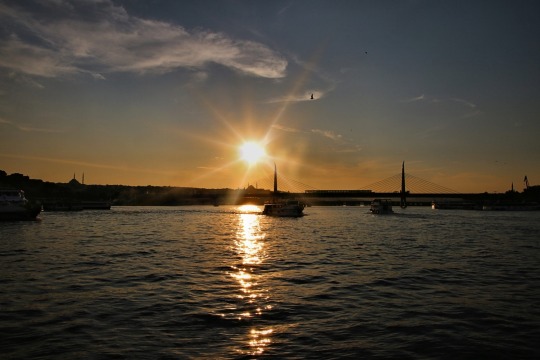
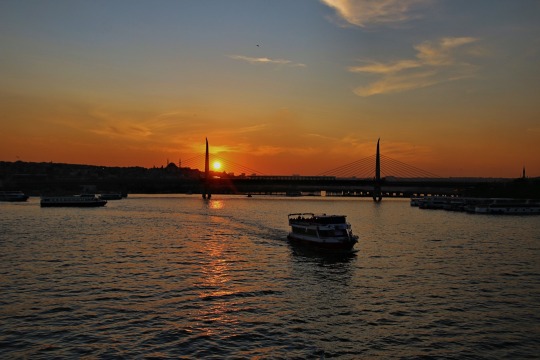
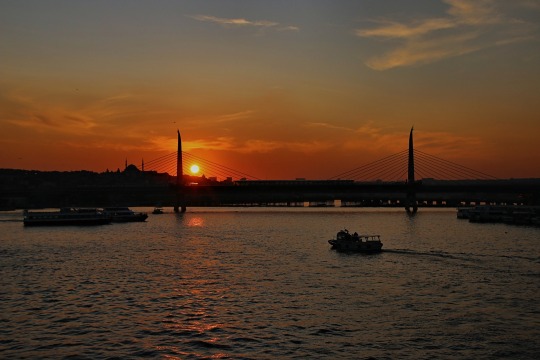
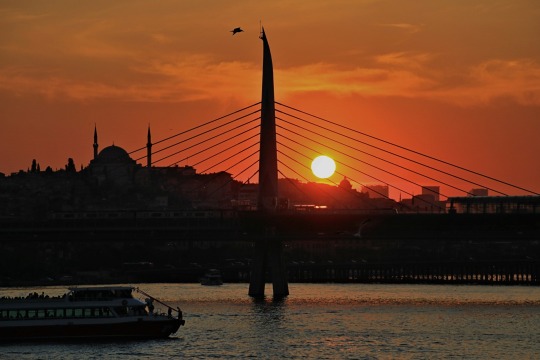
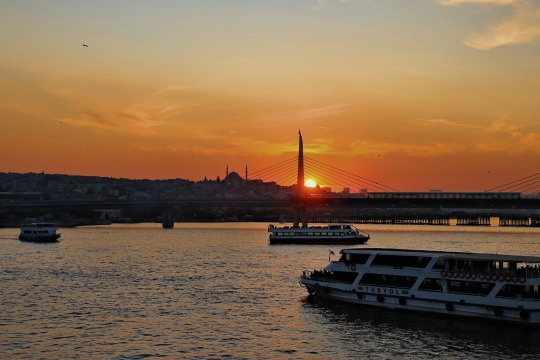
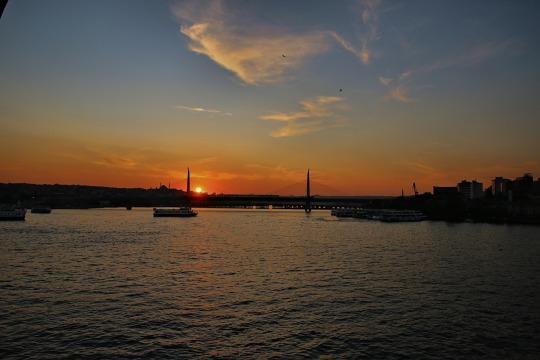
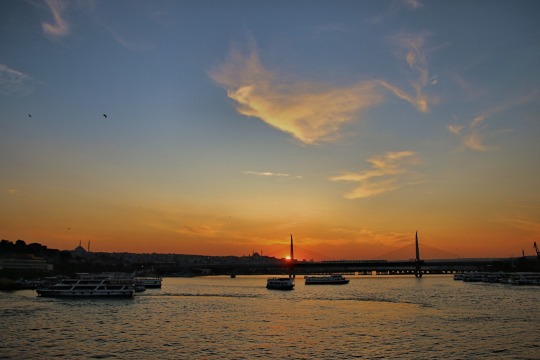
Sunset over the Golden Horn
#bosporus#golden horn#sunset#timelapse#golden horn metro bridge#ferry#boat#boat ramp#ocean#bosphorus strait#marmara sea#eminonu#pier#istanbul#turkey
14 notes
·
View notes
Text
Turkish Delights
Istanbul things //
First evening: Dinner at Karakoy Lokantasi (fried zucchini, marinated fish, seabass, fig dessert) and Pera Palace
First day: Topkapi Palace Tour; breakfast at Resto Han (first Turkish coffee); lots of walking around Sultanahmet District (Spice Bazaar, Suleymaniye Mosque, Grand Bazaar, Blue Mosque, Hagia Sophia, Basilica Cistern); seabass at Seven Hills with the epic sunset views; whirling Dervishes show; night walk back through Blue Mosque & Hippodrome
Second day: Walk from Sultanahmet to Galata for Galata Tower views; village breakfast at Café Privato; Turkish Bath at Hurrem Sultan Hamam; Bosporus sunset cruise; dinner at Eleos Restaurant (grilled octopus, blue fish)
Third day: Dolmabahce Palace; Istanbul Modern Art Museum; Aperol spritz and sunset view from Bank Roof Bar; tasting menu at Aheste
Cappadocia things //
Open-air museum, Esentepe, Pasabag mushroom shaped fairy chimneys, Avanos art town, Uçhisar Castle, balloon sunrise, Pigeon Valley, 4000 years old Underground city, Red and Rose Valleys, Cavusin Village
Delights //
First glimpse of the deep blue water; upgrade to Executive Suite and view from terrace; the fantastic wine and sea bass at Karakoy Lokantasi; inhaling the menthol tea in the spice bazaar — senses bewildered! / how visually stimulating all the teas and spices were; Turkish coffee and its presentation in the little cups; smell of grilled street corn; first impressions walking into the Suleymaniye, Blue, and Hagia Sophia mosques (while barefoot on soft carpet); the way the lights changed in the Basilica Cistern; unforgettable sunset with the birds on the Seven Hills terrace; whirling dervish show (and thinking it was going to be choreographed!); few moments almost alone in the Blue Mosque courtyard at night; power walking and listening to music while walking over to Galata; watching the fishermen at Galata bridge; village breakfast at Cafe Privato and the cinnamon honey tea; Turkish bath and all the accompanying sensations (white marble with gold fixtures, different temperatures of water splashed with a gold bowl, watching my dead skin rub off, lying on the center marble slab (being led everywhere by hand) and feeling the fluff of bubbles sitting on my skin while massaged, naked women everywhere just being rubbed); gorgeous sunset on the Bosporus cruise with nice couple; grilled octopus at Eleos; so many nose jobs!; the way the mosques are lit up at night; the shape of the Turkish tea glass; cuddly cat outside Dolmabahce Palace; In Another Place photo exhibition by Nuri Bilge Ceylan at the Modern Museum; birds on the Modern Museum’s terrace; sunset and purple olives at Bank Roof Bar; Aheste five-course tasting menu; first glimpse of Cappadocia’s chimney sweeps; hot air balloon sunrise; fun people on the Southern Loop tour; epic hike through Rose / Red Valley with Nevzat ("Zorba the Turk")
0 notes
Text
Days 67-68 – Sunday-Monday, 30-31 July
Sunday
We were woken a little before 5am by the call to prayer blasted from the Hagia Sophia mosque a hundred metres outside our window – I remember that from last time too. It happens five times a day, every day, unless their PA system breaks down. Fortuitously, I think that happened tomorrow – it sounded as if they were doing sound checks after the morning prayers and when the lunchtime call was due, we could hear it from other mosques, but not Hagia Sophia. But they only missed half a day and it was soon shaking the foundations again. We thought they must be broadcasting a recording, but we later saw a couple of imams standing on the balcony an bellowing into a microphone. It is a very strange call with seemingly impromptu elaborate 'tunes' incorporated into the call.
We had breakfast up on the rooftop with the Gulls and Crows flying all around, landing on the balustrade and looking for an opportunity to steal someone’s breakfast. Not today, but I recall people losing their breakfast to the gulls last time and I am sure it is a regular source of food for these determined birds.
We had a bit of a rest after breakfast before going out just before noon to follow the tram tracks down to the Bosphorus. We had lunch at one of the restaurants on the Galata Bridge and watched hundreds of tiny fish being caught by the hundreds of fisher-people on the bridge above us. The biggest fish we saw caught was about eight or ten centimetres long, and nothing was thrown back in, so I imagine whitebait is on the menu for a lot of locals tonight.
We walked through the Spice Market, operating there since 1603! There were dozens of stalls selling scores of spices and even more stalls selling even more different forms of sweetcakes, many varieties of baclava, but heaps of other things too. Then there were the jewellers with eye-wateringly brilliant displays of gold, silver and precious stones – no doubt, some may even have been genuine. Aladdin and a dozen other fabulously dressed up creatures were touting for the tourists’ dollars, but we spent very little – just a few sweet things to take back to the room. It was incredibly crowded and I was a bit concerned about pickpockets – my backpack was constantly being touched and we got out of there after half an hour or so.
We walked through the forecourt of the New Mosque that is no longer new - it is still called that and it remains as massive as it was when it was reconstructed as the New Valide Sultan Mosque some 358 years ago – so it is sort of almost new. There are probably thousands of newer mosques in Istanbul today, but habits are hard to break. Heather ventured inside, but taking my shoes on and off is a chore, so I stayed out in the forecourt, a marvel in itself. I have to admit, I am still a little uncomfortable with the requirements of the Moslems and find the tiny eye-slits in a phalanx of black burqas quite confronting.
We were trying to find a cruise that took us up to the Black Sea, but it seems there aren’t any. We asked at numerous places and although we have a brochure advertising one cruise that goes to the mouth of the Bosporus at the Black Sea, it turns there and retraces its path back to Istanbul without landing at the Black Sea. We sat in the shade of a tree in a park that I remembered well from our last visit, debating what to do, and eventually decided to return to the hotel along the tram-tracks to where I had seen a different travel agent in the morning. As it turned out, we were dragged into another travel agency ten metres shy of the one I was aiming for, on the other side of the road.
This guy there was really helpful (everyone here has rellos in Australia and wants to talk about the country) and he sold us on a 16-hour bus tour that goes up to the Black Sea and stops for a couple of hours at two villages on the coast of the Black Sea on the Asian side. We had really intended going by boat, but this looks better and is relatively cheap – he even 'did us a deal' and I have seen the same tour advertised at more than twice what he charged us.
We stopped in at a tiny shop to buy some booze and more water and then at an equally quaint minimart to buy some more snacks and treats as we trudged up the steep hill towards our hotel. We rested for an hour or two with a cold drink before going out to dinner.
We went to an Indian Restaurant just past the place we ate yesterday afternoon and had a great meal – bringing home the inevitable doggy box. We had quite a long conversation with the couple at the table next to us (the tables are about 25 centimetres apart) and when they left, another interesting couple sat down. We sat and enjoyed our meal very slowly and had a bit of a chat with the new couple – very interesting discussion again, but not as long as with the previous couple. We all got up to pay our bills and leave at about the same time but when we went to pay, we were told that the other couple had already paid for us as well as their own meal. I suspect from our conversation that they are reasonably well off, but this was an extraordinary thing to do. We were very touched and thanked them profusely – it was a bit embarrassing really, but such a beautiful thing for them to do. Perhaps it had something to do with their religion – she was obviously Moslem but I was not so sure about him. Certainly a very lovely thought, and we walked home with a very warm feeling about them.
Monday
We had a late start followed by breakfast on the rooftop again. Heather spent a lot of time trying to organise a tour to Gallipoli. The website was hopeless so she eventually went down to Reception where the Manager organised it for us. He had to ring them and text them and pay a deposit that we had to reimburse in US dollars – all very complicated, but at least it is done and we now have a very long tour to the Black Sea tomorrow and an even longer one on Wednesday to Gallipoli – and maybe another one going nowhere just for show. (Thanks Topol.)
In the meantime, I was trying to move some money out of our normal account so we could access it from an ATM – and the morons at Commonwealth Bank locked me out of our account until we get home again. They required the iniquitous 2-factor identification that can only be done by phone – and we don’t have a usable phone with us. Not to worry, their website says that if you are overseas and don’t have a phone, just ring this international number in Australia (without a phone) and we will tell you that you can’t access your money overseas anyway. What a bunch of Cretans!!! The only way you can communicate with the CBA is by phone or in a branch – and most of the things you might need to do can’t be done in a branch. Another account to be closed when we get home! (I subsequently found a way to access the account from my PC but hope we don't need to access the money anyway.)
We went out for lunch just up the road from here – and we paid our own bill there. We then went to a supermarket (quite a big one) a block or so further away to buy some snacks for our long drives tomorrow and the next day. Breakfast and lunch are included but we might still need some nibbles in between.
We spent the afternoon in our room and returned to our lunchtime restaurant for dinner at night. It was nice to be recognised and welcomed by the staff.
0 notes
Photo

Galata Bridge to Ayub
EXCURSIONS
The best way to see the Golden Horn is by going up it in a fair-sized caique pulled by two men. Fare 15 to 20 piastres (2s. 6d. to 3s. 4d.) there and back. The small steamers plying between Galata Bridge and the various stations on the Inner Horn are both uncomfortable and dirty, and on account of their awnings utterly unsuitable for sight-seeing. Fare (Galata Bridge to Ayub) 50 paras (2nd.).
The Golden Horn, or Bay of Constantinople, extends from its junction with the Bosporus at Seraglio Point to a spot away up the harbour, called the Khlyat Haneh or Sweet Waters of Europe, at the confluence of two small streams, the Kedaris or Ali bey Suyu, and the Vorvlsses or Khlyat Haneh Silyu, and separates Galata and Pera from the Stambul side of the city. Its names of Keratios Kolpos (The Horn Gulf) and Chrysokeras (Golden Horn) are derived from the resemblance of this arm of the Bosporus to the shape of a ram’s horn.
The Golden Horn is some six miles long, with an average width of about 490 yards, and a mean depth of twenty-three fathoms, and is spanned by two bridges. In olden times it was closed during the various sieges by a chain stretched across it, from Seraglio Point to Galata.
The most interesting suburbs on the Golden Horn are—Galata, Pera, Kassim Pasha, Phanar, Balata, Haskeui and Ayub.
Galata was originally known under the name of Sykce (fig-trees), presumably from a grove of fig- trees having once existed there; but the place was afterwards called Galata, from the Gauls who formed a settlement there ; and this name has clung to it throughout its subsequent occupation by the Genoese, down to the present day. Galata is now the place where the banks, steamship agencies, stock exchange, and offices of agents and representatives of European firms are established. The old Genoese walls which formerly enclosed Galata have been pulled down years ago to make way for the erection of modern buildings, and scarcely a vestige of them now remains.
0 notes
